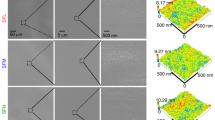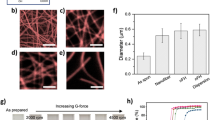Abstract
Functional relationships between the biomaterial interface and extracellular matrix (ECM) proteins are intimately involved in cellular adhesion and function. Structural changes of ECM proteins upon adsorption to a surface alter the protein’s biological activity by varying the availability of molecular binding sites. Recent work using native and organically modified sol-gel silica as a neuronal biointerface revealed that changes in surface nanotopography of bulk versus thin film materials result in dramatic differences in fibronectin structure, cell survival, and neuronal differentiation. In order to further investigate interactions between chemical functionality and surface topography, we evaluated the global conformation of human fibronectin adsorbed to seven different organically modified silica gels and thin films. Chemical functional groups were introduced into the materials either by altering the starting precursor or by doping with poly-l-lysine or polyethylenimine. Surface topography measurements by atomic force microscopy show that films have surface features less than 25 nm while bulk materials of the same precursor chemistry have features ranging from 50 – 100 nm in size. Fluorescence resonance energy transfer spectroscopy (FRET) revealed a strong interaction between surface topography and chemical functionality. Fibronectin remain globular on all bulk materials regardless of chemical modification. The same changes in precursors or dopant chemistry, however, induced changes in the conformation of fibronectin on the thin films. The differentiation of PC12 cells on the surface indicated a strong impact of the surface features and suggest a possible optimal fibronectin folding state.
Similar content being viewed by others
References
G. L. Baugh and V. Vogel (2001). “Coexisting conformations of fibronectin in cell culture imaged using fluorescence resonance energy transfer.” PNAS 98(25): 14464–14468.
L. and V. Vogel (2004). “Structural changes of fibronectin adsorbed to model surfaces probed by fluorescence resonance energy transfer.” Journal of Biomedical Materials Research 69A(3): 525–534.
S. S., J. L. McKenzie, S. J. Leavesley, K. M. Little, T. J. Webster, J. P. Robinson, D. E. Nivens and J. L. Rickus (2006). “Sol-gel derived materials as substrates for neuronal differentiation: effects of surface features and protein conformation.” Journal of Materials Chemistry 16: 3221–3230.
B. G., D. M. Collard and A. J. GarcÌa (2003). “Surface chemistry modulates fibronectin conformation and directs integrin binding and specificity to control cell adhesion.” Journal of Biomedical Materials Research Part A 66A(2): 247–259.
B. J. and M. H. Schoenfisch (2005). “In vitro cytotoxicity of nitric oxide-releasing sol-gel derived materials.” Biomaterials 26(21): 4405–4415.
C. D. Avnir and R. Armon (2004). “Tissue-derived growth on hybrid sol-gel films.” Journal of Materials Chemistry 14: 2200–2205.
Author information
Authors and Affiliations
Rights and permissions
About this article
Cite this article
Jedlicka, S., Leavesley, S.J., Little, K.M. et al. Interactions Between Chemical Functionality and Nanoscale Surface Topography Impact Fibronectin Conformation and Neuronal Differentiation on Model Sol-gel Silica Substrates. MRS Online Proceedings Library 950, 413 (2006). https://doi.org/10.1557/PROC-0950-D04-13
Received:
Accepted:
Published:
DOI: https://doi.org/10.1557/PROC-0950-D04-13




